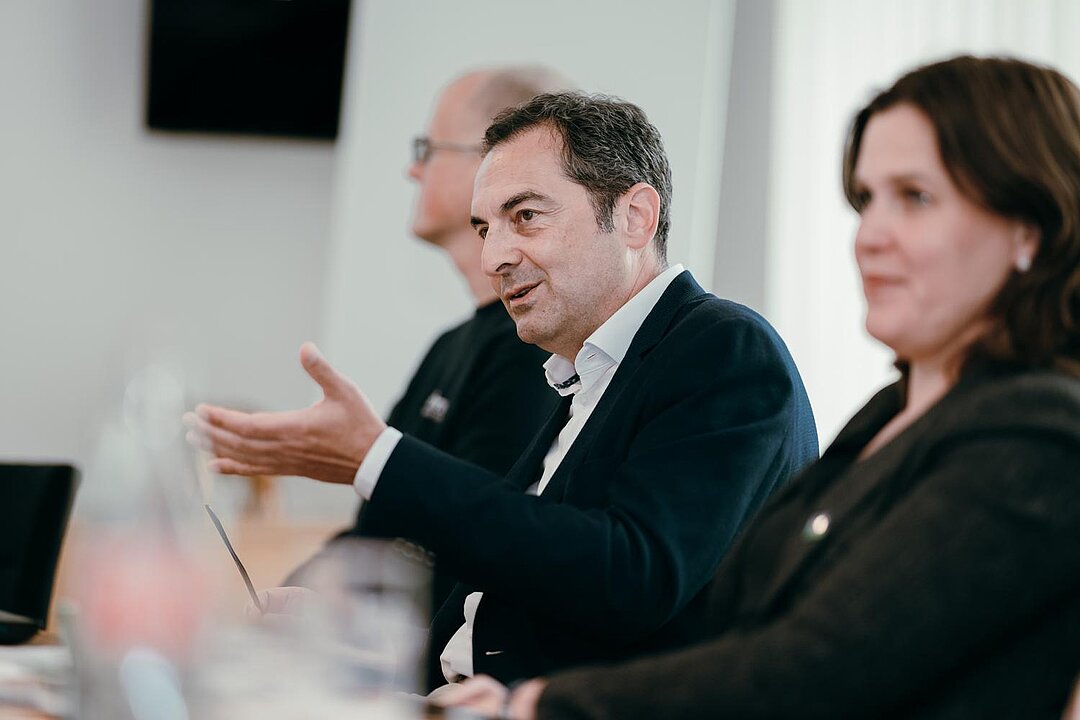![[Translate to English:] [Translate to English:] Rasem Baban neben Verena Dietl mit neuer Artenschutzstrategie](/fileadmin/_processed_/0/3/csm_tierpark-hellabrunn-artenschutzstrategie-verena-dietl-rasem-baban_85c265d709.jpeg)
Hellabrunn Zoo has taken an important step to maximise its impact in the global fight against extinction with the launch of a new conservation strategy.
It features an integrated approach to conservation, a key objective in the Munich zoo’s mission statement, and includes a commitment to improve awareness and educate the public through local and global conservation projects. As an ambassador for biodiversity, Hellabrunn Zoo has just launched a new conservation strategy, which will set new standards for the animal park in Munich. Modern zoos offer more than just a place for recreation. They also play an important role in species conservation, research and science as well as animal welfare, and are committed to protecting endangered species and their habitats.
This commitment was reaffirmed at the presentation of the new Hellabrunn conservation strategy on Tuesday, 10 June 2024, by Verena Dietl, mayor and chair of the supervisory board at Hellabrunn Zoo: "Hellabrunn Zoo cannot protect species on its own. Conservation efforts can only succeed if we work together with a wide range of partners. With this in mind, Hellabrunn is promoting the concept Together for Biodiversity."
Science-led zoos such as Hellabrunn Zoo play a crucial role in protecting endangered species and in environmental education. By caring for at-risk species and promoting education and research, they help to raise public awareness about species conservation and inspire sustainable action. Another essential contribution to species conservation is the support they provide to conserve endangered species on our doorsteps and the local animals' natural habitats.
"Our world is facing enormous challenges, largely caused by man-made climate change and biodiversity loss. This loss is the result of unsustainable use of resources and unregulated industrialisation," said Rasem Baban, zoological director of Hellabrunn Zoo: "Despite international efforts to protect biodiversity, more than a million species are threatened with extinction."
Holistic concept: The One Plan Approach
"A key component of the new Hellabrunn conservation strategy is the One Plan Approach (OPA), which combines in-situ and ex-situ measures to protect all populations of a species. By using the world's largest wildlife database, Species360, this ensures effective coordination and implementation of species conservation measures," added Baban. The aim of the One Plan Approach is to jointly develop management strategies and conservation measures for all populations of a species within and outside their natural range - an approach that looks beyond the boundaries of the zoo and aims for long-term interdisciplinary partnerships for species conservation.
Hellabrunn Zoo's new conservation strategy not only focuses on protecting individual species, but also addresses the underlying causes of species extinction. Targeted measures are intended to comprehensively protect, restore and secure not only the species themselves, but also their habitats. In order to consolidate and broaden Hellabrunn's positive influence on species conservation worldwide, the One Plan approach aims to work even more closely with partners in the species' natural habitats.
"The new conservation strategy will further strengthen our Geo-Zoo of Biodiversity concept. Our zoo in Munich has been a geo-zoo since 1928, making it the first geo-zoo in the world," added Dietl. "In addition to sharing knowledge and experience on conservation projects, Hellabrunn is also strengthening its internal nature conservation concept and internal sustainability management."
In future, the zoo plans to implement on-site conservation projects, so-called core projects, tailored to each of the nine geo-zones at Hellabrunn, which will be given extensive support. For the geo-zones World of Apes and Asia, these core projects have already been established with the cooperation of the Fundación Jocotoco and the Cikananga Conservation Breeding Center. The core projects are intended to cover a broad taxonomic diversity and also protect less popular species such as fish, amphibians and insects. A comprehensive evaluation matrix was developed to select the core projects, which will be used to evaluate existing and future projects.
Conservation through interdisciplinary research and knowledge sharing
Hellabrunn Zoo aims to make its conservation work transparent and engaging for visitors through educational presentations at the zoo. Communication measures will be used to spread the zoo's commitment and provide deeper insights into its conservation efforts. Hellabrunn is also actively involved in knowledge sharing and interdisciplinary research on species conservation. The zoo aims to develop scientifically based solutions that can be applied worldwide and plans to achieve this through international cooperation as well as through training of new conservation ambassadors.
"The introduction of this new conservation strategy marks the beginning of a long-term initiative by Hellabrunn. The zoo will continually evaluate the strategy and adapt it to new challenges to ensure that it always remains targeted and relevant," concluded Baban.
